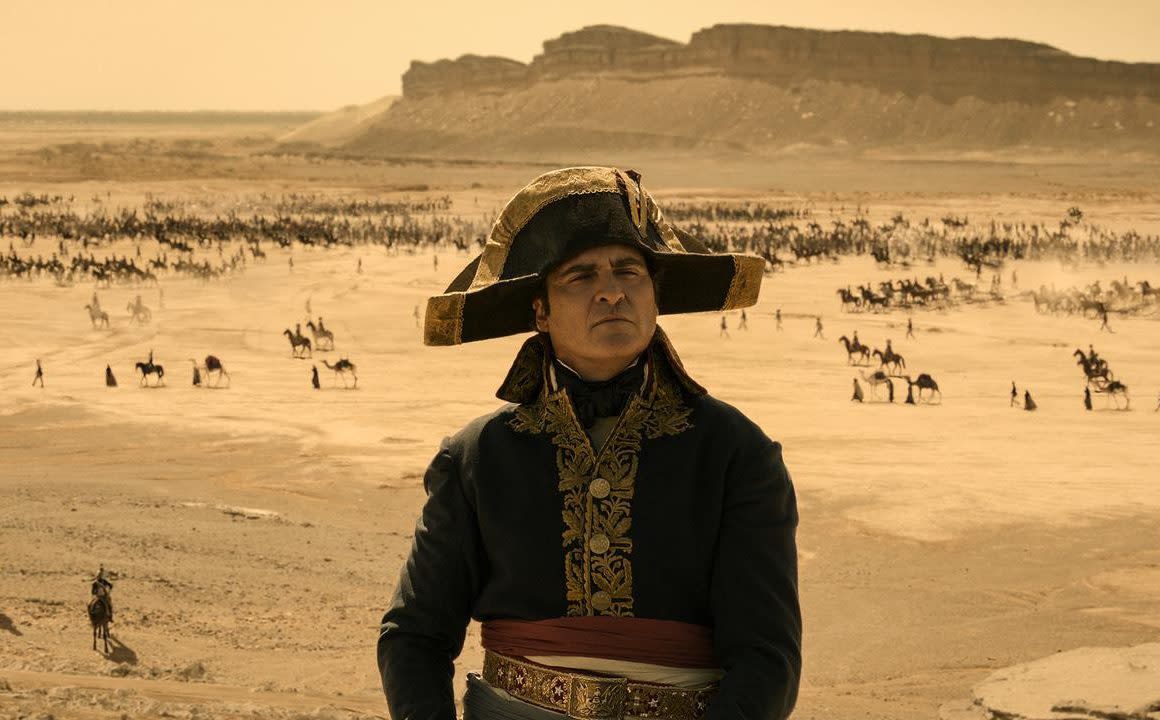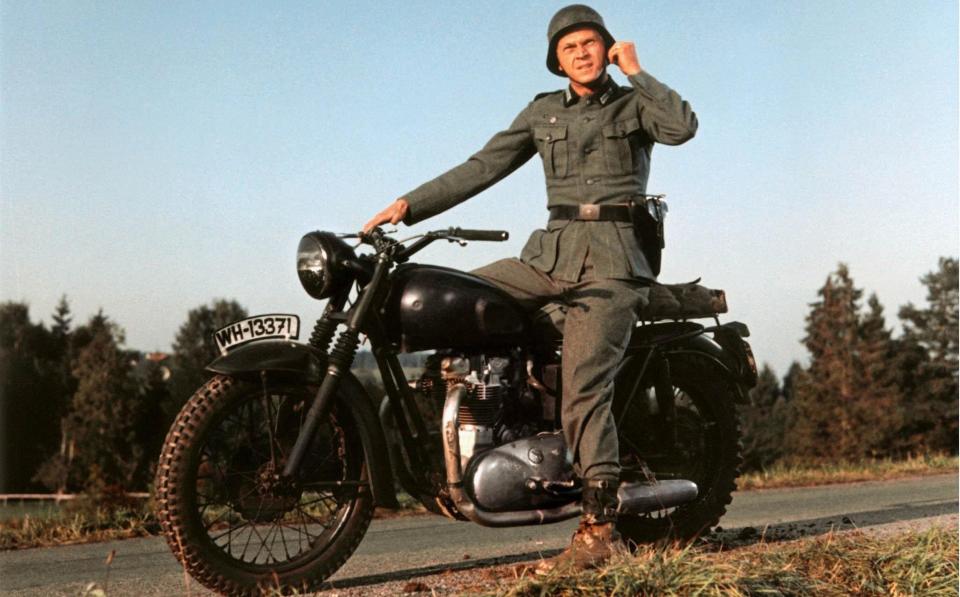Who cares what Napoleon gets wrong? Facts are the enemy of great art

- Oops!Something went wrong.Please try again later.
- Oops!Something went wrong.Please try again later.
- Oops!Something went wrong.Please try again later.
- Oops!Something went wrong.Please try again later.
The Frogs have been getting uppity over Joaquin Phoenix’s depiction of Napoleon, in Ridley Scott’s new blockbuster. Their historians point out the real Boney didn’t participate in cavalry charges, fire cannonballs at the pyramids, and nor was he present in Paris at the execution of Marie-Antoinette – in October 1793 Napoleon was hundreds of miles away, earning distinction at the Siege of Toulon. Historians may also wish to note that Joaquin Phoenix keeps his hat on indoors and doesn’t bother with a Corsican accent.
Scott has been unperturbed by the complaints ( “How do they know? Were they there? Tell that to your f-cking historians”), and I think he is right. At Oxford we used to ask entrance candidates, “How do we know Wellington won at Waterloo? None of us were present.” In other words, what is meant by verification? There’s always bias, conjecture, even in first-hand reports, newspaper digests, eye-witness accounts. As Groucho Marx said to Margaret Dumont, “Who are you going to believe? Me, or the evidence of your own eyes?” Things are slanted, stretched, bamboozled.
History is an agreed fiction, and films are not documentaries. In Désirée, Marlon Brando’s Napoleon loses Waterloo because he is fatigued by his relationship with Eugénie Désirée Clary, later Queen of Sweden, played by Jean Simmons. In Waterloo, which I loved as a child, Rod Steiger howls and perspires, the battle not going his way because his piles are inflamed. Is this more or less plausible than the Napoleon in Bill and Ted’s Excellent Adventure, who time-travels to a water park in San Dimas, California, coincidentally called Waterloo, where he discovers ice-creams and enjoys himself hugely?
Pedantry is the enemy of art. It has never mattered to me if the upholstery in a GWR carriage is inexact, as some viewers complained about Poirot episodes. When Tony Richardson’s Tom Jones was first released, I had colleagues in the English Faculty who were furious the wisteria climbing up a manor house was anachronistic. It’s like the way pointing out errors in The Crown has become a national sport – Diana never chose an engagement ring in Monte Carlo, Martin Charteris appears in scenes set in 1979 when he retired in 1977, Prince Philip was not quite the sneering panto villain depicted by Matt Smith, nor did he possess the Stan Laurel face of Jonathan Pryce, come to that.
Nor, I dare say, did Diana re-appear in ghostly guise to address Charles, the Queen, and Mohamed Al-Fayed. But there is a precedent. In Richard III, the spectres of the king’s victims visit him before Bosworth ( “Dream on, dream on, of bloody dreams and death” ) – and I applaud the invention of Peter Morgan. Similarly, in Schiller’s play Mary Stuart, first performed in 1800, as adapted by Donizetti for his opera, the big scene is the confrontation between Mary Queen of Scots and Elizabeth I – and yet, though they never met in real life, the encounter now seems crucial to the story, as discussed in Stefan Zweig’s biography, and as depicted in a film with Vanessa Redgrave and Glenda Jackson.
The monarchy is indeed a popular topic for artistic licence, speculation, goofs. To celebrate Elizabeth II’s Coronation, Britten came up with Gloriana – how well did he expect his portrait of a disease-ridden, lonely and hysterical queen to be received? In presenting an Elizabeth I devoid of human warmth, had the composer offered up a prophecy? The atmosphere in the Royal Box at Covent Garden will have been strained.
Hilary Mantel made her name rearranging Tudor history, making use of period details to create new narratives about Henry VIII and Anne Boleyn, who have long been popular characters. Richard Burton and Genevieve Bujold were notable in Anne of the Thousand Days, and Burton’s Oscar-winning costumes were later worn by Sid James in Carry On Henry, about whom it was stated on the poster: “A great guy with his chopper.”
The Carry Ons were notorious for their continuity errors. Does it matter particularly that Charles Hawtrey, as Sir Roger de Lodgerley, wears NHS spectacles or that Bill Maynard plays Guy Fawkes, who was born twenty-three years after Henry VIII died? The characters also drink tea, several hundred years before the beverage was introduced to these islands, and stroll around the grounds of Windsor Castle, as laid out in the eighteenth-century.
I doubt a film has been made that is free from cock-ups. In The Sound of Music, instead of heading for Swiss freedom at the finish, the Von Trapps climb a mountain path west of Salzburg that leads directly to Hitler’s Berchtesgaden compound. As a Catholic family, throughout the picture they observe Protestant prayers. Also, context counts. To most of the world, Christopher Plummer’s captain is a hero – not in Austria, where he was viewed as a deserter.

War sagas are particularly prone to mishaps. In The Great Escape, captured RAF pilots carry suitcases and POWs wear wristwatches and signet rings, which in reality guards confiscated or stole. Steve McQueen escapes on a Triumph 650, manufactured in 1963, and James Coburn escapes over the Pyrénées to Spain, which implies he walked through most of Germany and the entirety of Occupied France undetected. In Pearl Harbor, the Soviet Union is on the wrong side, nurses on duty, like Kate Beckinsale, wear full glamorous make-up, and bombers fly at high altitudes, where they flew at low altitudes to avoid radar.
But who wants cinema to be school, or for theatre and literature to be college lectures? This was all a theme, incidentally – that nothing really may be known completely – running through my own recent book about Richard Burton and Elizabeth Taylor. Examining, comparing, and contrasting the many previous biographies, I found them full of discrepancies – dates, whereabouts, addresses, recollections; it was as if nothing may be allowed to stand still, everything must keep shifting about, as if set on movement. Burton’s own diaries also contained warped chronologies, material shoved in later, in variously drunk or sober moods.
Peer through the microscope, matter, once inert, squiggles around. Which begs the larger question: what, after all, are facts, which in any case never speak for themselves? Life gets to be uncertain; nothing adds up – just as, in Cleopatra, Taylor’s sandals and high heels, costumes and wigs, switch from shot to shot. Her Egyptian queen, moreover, enters Rome beneath the Arch of Constantine, which was built 350 years later, and then not in the Forum. Senators in Twentieth Century Fox’s view of the classical past wore purple togas, a colour reserved in actuality exclusively for the emperor – though in Carry On Cleo what they wear are red Marks and Spencer’s underpants.
“What a romance my life has been!” exclaimed the historical Napoleon, understanding his career was the stuff for novelists (Tolstoy) or musicians (Beethoven), which means also his was an existence ripe for perpetual contradictory assessment or controversial reassessment. Events will be restructured, re-shaped, form and content pulling against each other – as they do in an inadvertently comic fashion in another one of Ridley Scott’s films, Gladiator. In that one, Maximus’s dog is an Alsatian, which wouldn’t be bred until 1899, a gladiator uses a flail, a weapon devised in the late medieval period, statues carved by Canova in 1795 decorate Commodus’s palace, and spectators in the crowd wear sunglasses.
Who said Hollywood has a duty to photograph reality? It’s entertainment.
Napoleon is in cinemas now
Roger Lewis’s Erotic Vagrancy: Everything About Richard Burton and Elizabeth Taylor (riverrun) is out now

